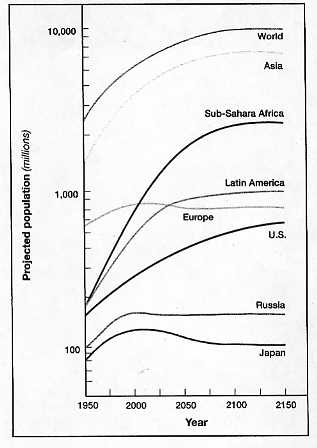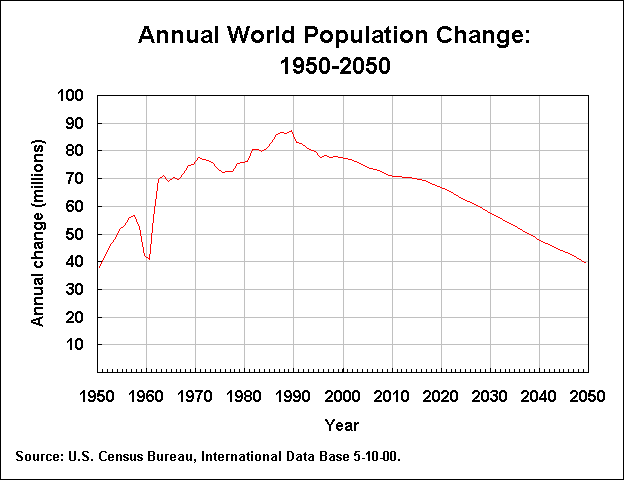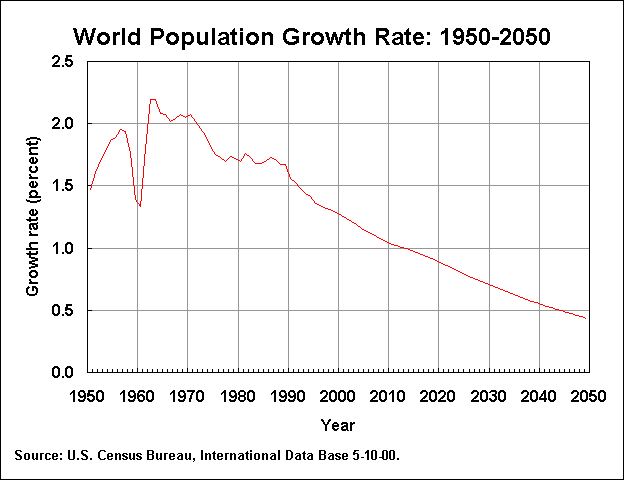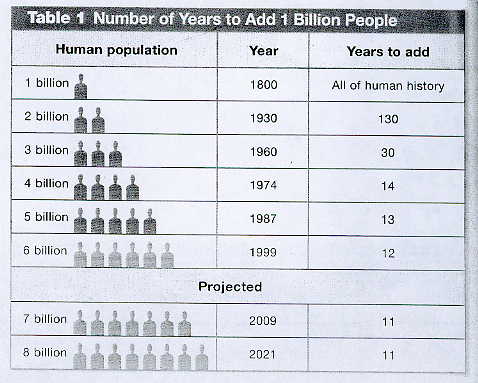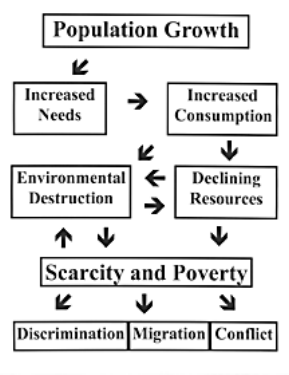|
Links |
|
Links |
|||
|
|
- Project: Your Families' Population Growth |
|
|||
| POPULATION GROWTH WAS SLOW UNTIL 1000 AD, THEN INCREASED STEADILY UNTIL THE INDL AGE, WHEN IT 'EXPLODED' | |||||
|
|
Charts on World Population Growth |
|
|||
|
|
By any measure, the world population has grown rapidly |
|
|||
|
|
The Chart on Historical World Population Growth shows that pop growth was slow until 1000 AD, increased steadily until the indl age, when it 'exploded' |
|
|||
| 1993 32 countries had increased growth rates
1993 5.685 bb 1999 6.000 bb milestone 2000 6.043 bb 2007 6.639 bb 11/19/10 6,882,530,989 |
|||||
| World Pop Clock http://www.census.gov/ipc/www/popclockworld.html |
|
||||
| - Supplement: The Population Clock, 2000 |
|
||||
| POPULATION DENSITY EXAMINES HOW MANY PEOPLE LIVE IN AN AREA | |||||
|
|
World population density is very unequal in that while 63 % of land mass is north of equator, 90 % of population is north of equator |
|
|||
| Most of the population lives on 10 % of land | |||||
| Crude population density measures the population per sq mile or sq kilometer |
|
||||
| Nutritional density measures the population per sq mile of cultivable land | |||||
| Agricultural density measures the population of farmers / etc. per sq mile of cultivable land | |||||
| Healthcare density is measured by the number of doctors per 1,000 population | |||||
| Population pyramids are histograms turned vertically |
|
||||
| A Cohort is a group who share a common temporal demographic
experience
Youth Cohort less than 15 yrs Middle Cohort 15 - 64 yrs Old Cohort more than 64 yrs |
|
||||
| The youth cohort consists of those who are less than 15 yrs old | |||||
| The middle cohort consists of those who are btwn 15 & 64 yrs old | |||||
| The old cohort consists of those who are more than 64 yrs old | |||||
| The dependency ratio: is measured by adding the youth & old cohorts & dividing that sum by the middle cohort: Y + O / M |
|
||||
| - Supplement: Swedish Population Pyramid |
|
||||
| - Supplement: US Population Pyramid: 1900 |
|
||||
| - Supplement: US Population Pyramid: 1990 |
|
||||
|
|
There are many social factors affecting population growth including
the
|
|
|||
Common general factors affecting pop growth include
|
|||||
| 1. The crude birth rate ( CBR ) is the number of live births per 1000 people |
|
||||
| 2. The doubling time is the number of years it takes a population to double : today 1.8 % growth = doubling in 40 yrs |
|
||||
| Today, w/ a growth rate of 1.8%, the world pop will double in 40 yr, i.e. be 12 bb in 2040, 24 bb in 2080 | |||||
| 3. The crude death rate (CDR) is the number of deaths per 1,000 people |
|
||||
| The factors affecting the CDR include healthcare, disease, food, war, etc. | |||||
| The increase/decrease in the population = CBR - CDR | |||||
| 4. The total fertility rate (TFR) is the number of births per woman of child bearing age: 15 - 49 yrs |
|
||||
| The TFR peaked in US at 3.7 | |||||
| The TFR is a better predictor of population than CBR | |||||
| 5. Infant mortality rate is the number of deaths of infants less than 1 yr. old per 1,000 live births | |||||
| Infant mortality rate is often used as a measure of healthcare & as a non econ measure of development | |||||
| 6. Life expectancy is the average number of yrs a cohort is expected to live | |||||
| AIDS is among the top 10 leading causes of death in US | |||||
|
|
7. THE DEMOGRAPHIC TRANSITION (DT) OCCURS WHEN HIGH BIRTH & DEATH RATES ARE REPLACED BY LOW BIRTH & DEATH RATES | ||||
| At the beginning of the DT there is high birth rates & death rates, which results in the highest population growth rate | |||||
| At the end of the DT, there is low birth & death rates which results in the lowest population growth rate | |||||
| As nations develop, usually the high death rate drops before the high birth rate drops so that many people are being born, & fewer are dying, resulting in the most rapid pop growth rates | |||||
| Death rates are often reduced by better food, healthcare, vaccines, etc. | |||||
| Birth rate reduction often opposed by custom, religion... esp. by peripheral countries | |||||
| The DT is perhaps humanities greatest chance for voluntary zero pop growth (ZPG) & responsible econ dev | |||||
| The DT can be seen in most western nations that have either ZPG or even negative population growth (NPG) | |||||
| The DT & ZPG can be seen in the US (however our pop is growth, but solely due to immigration), the UK, Fr, & Ger | |||||
| The DT & ZPG can be seen in Italy & Ireland which have falling populations | |||||
| The poorer a nation, the less developed it is, the more likely it is to have a pop explosion | |||||
| It is clear that at least some of the effect ot the DT is due to the acceptance of Western values related to the empowerment of women ,& men & women co deciding family size, career choices, etc. | |||||
| Societies w/ pop explosions generally maintain tradl values where the larger the family, the higher status of both the mother & the father, where the children give the parents old age security, where large numbers of children are a asset as a wkforce, where patriarchy / men rule the family w/ nearly absolute authority | |||||
| With econ dev, the DT, & western values, people eschew tradl values & large families convey no status, children are a liability / cost, where children do not serve as a wkforce, & where patriarchy does not rule, rather men & women co rule | |||||
| This combination of econ dev, the DT, & western value is a method that is extremely difficult to implement, but it can be effective in a few generations | |||||
|
|
8. POPULATION MOVEMENT IS AFFECTED BY PUSH & PULL FACTORS |
|
|
|
Push factors, i.e. those factors pushing a population out of an area include war, econ dislocation, ecological deterioration, political persecution, religious persecution, etc. |
|
|
|
Pull factors, i.e. those factors pulling a population to an area include econ opportunity, political freedom, religious freedom, peace, family, a good env, etc. |
|
|
|
In 1987, 32 mm people migrated
In 1993, 42 mm people migrated In 2000, 177 mm people migrated In 2005, 191 mm people migrated In the last 50 yrs more people migrated than in all of history |
|
| The UN World Migrant Stock http://esa.un.org/migration/index.asp?panel=1 |
|
|
| 9. VOLUNTARY MIGRATION OCCURS WHEN PEOPLE MIGRATE AS RESULT OF THEIR OWN DECISION | ||
|
|
Voluntary migration occurs when people migrate as a result of their own decision & not because of severe push or pull factors |
|
| In practice, it is difficult to differentiate btwn voluntary & forced migration because we often maintain our belief in free will when social factors are severely impacting our decision | ||
| While it may appear to many that the mvmt of people from rural to urban areas in the US was voluntary migration, one must consider that ag econ conditions made it impossible for many to earn even a subsistence living | ||
|
|
In the big picture, most people do not migrate voluntarily |
|
|
|
An example of voluntary migration is when Europeans guest workers migrate to the US & vice versa |
|
| 10. FORCED MIGRATION OCCURS WHEN PEOPLE MIGRATE AGAINST THEIR WILL | ||
|
|
Forced migration occurs when people migrate against their will as a result of severe push or pull factors |
|
|
|
Of the nearly 200 mm people who migrate each yr, most are forced to move |
|
|
|
In the 17th & 18th centuries, over 10 mm people were forced into slavery as a result of the world slave trade |
|
|
|
After WW1, 700 K Armenians were deported out of the Ottoman Empire after WW1 |
|
|
|
There was a large migration of Jews before, during, after WW2 both to Palestine, to estb Israel & to escape the Nazi holocaust |
|
|
|
Many people migrate to seek political asylum, i.e. escape political persecution |
|
| The US has accepted people, notably, from Vietnam & SE Asia, & now, the Mid East | ||
|
|
In the 1990s in Sudan the civil war, war, genocide & ecocide forced millions of its own citizens into internal & external migration & also accepted .75 mm immigrants from other countries |
|
|
|
The Palestinians have emigrated from their homeland, which is now Israel since 1948 Arab Israeli war, to a variety of Arab & African nations as well as the West Bank & Gaza Strip which are regions of Palestine |
|
| Ecomigration is the mvmt of populations caused by the degradation of land, water, etc. | ||
| 11. INTERNAL VOLUNTARY MIGRATION OCCURS WHEN PEOPLE MIGRATE W/IN A NATION AS A RESULT OF THEIR OWN DECISION | ||
|
|
Rural to urban migration is often cited as an example of internal voluntary migration, & indeed while many people choose the glamour & indl lifestyle of the city, many are forced into urbanization because of specific ag econ policies which drove people off the land |
|
|
|
A common example of internal voluntary migration is the migration of people from the Eastern seaboard to interior to real their goal of becoming self sufficient farmers |
|
|
|
From the post Civil War era until the 1960s, Blacks migrates out of the rural South to cities in South, North, & West |
|
|
|
After WW 2, middle & upper class people migrated out of the city to the suburban migration |
|
|
|
At the beginning of the post indl era, circa 1980, displaced indl wkrs & others migrated from the rustbelt to the sunbelt | |
| 12. INTERNAL FORCED MIGRATION OCCURS WHEN PEOPLE MIGRATE AGAINST THEIR WILL | ||
| Internal forced migration occurs when people migrate win a nation against their will as a result of severe push or pull factors | ||
| An example of internal forced migration in the US is the Trail of Tears which occurred when 16,000 Cherokees were forced to march from the Southeast to OK as a result of the Indian removal act of 1830 | ||
| An example of internal forced migration is the forced mvmt of Native American to Reservations | ||
| An example of internal forced migration in China in the 1960s & 1970s was the relocation of 15 peasants & intelligentsia to rural communes for Maoist re education |
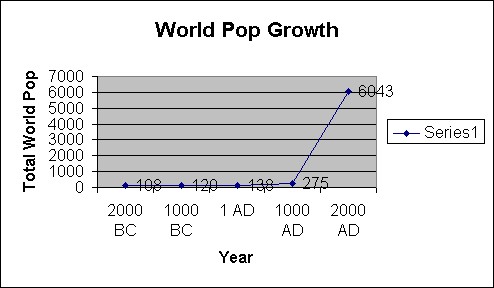 |


